Prenatal alcohol exposure and chronic mild stress differentially alter depressive- and anxiety-like behaviors in male and female offspring
- PMID: 20102562
- PMCID: PMC4833468
- DOI: 10.1111/j.1530-0277.2009.01132.x
Prenatal alcohol exposure and chronic mild stress differentially alter depressive- and anxiety-like behaviors in male and female offspring
Abstract
Background: Fetal Alcohol Spectrum Disorder (FASD) is associated with numerous neurobehavioral alterations, as well as disabilities in a number of domains, including a high incidence of depression and anxiety disorders. Prenatal alcohol exposure (PAE) also alters hypothalamic-pituitary-adrenal (HPA) function, resulting in increased responsiveness to stressors and HPA dysregulation in adulthood. Interestingly, data suggest that pre-existing HPA abnormalities may be a major contributory factor to some forms of depression, particularly when an individual is exposed to stressors later in life. We tested the hypothesis that exposure to stressors in adulthood may unmask an increased vulnerability to depressive- and anxiety-like behaviors in PAE animals.
Methods: Male and female offspring from prenatal alcohol (PAE), pair-fed (PF), and ad libitum-fed control (C) treatment groups were tested in adulthood. Animals were exposed to 10 consecutive days of chronic mild stress (CMS), and assessed in a battery of well-validated tasks sensitive to differences in depressive- and/or anxiety-like behaviors.
Results: We report here that the combination of PAE and CMS in adulthood increases depressive- and anxiety-like behaviors in a sexually dimorphic manner. PAE males showed impaired hedonic responsivity (sucrose contrast test), locomotor hyperactivity (open field), and alterations in affiliative and nonaffiliative social behaviors (social interaction test) compared to control males. By contrast, PAE and, to a lesser extent, PF, females showed greater levels of "behavioral despair" in the forced swim test, and PAE females showed altered behavior in the final 5 minutes of the social interaction test compared to control females.
Conclusions: These data support the possibility that stress may be a mediating or contributing factor in the psychopathologies reported in FASD populations.
Figures


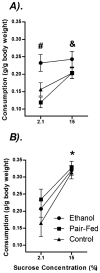
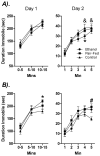
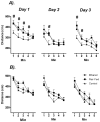
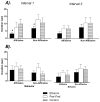
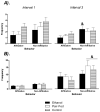
References
-
- Alonso SJ, Castellano MA, Afonso D, Rodriguez M. Sex differences in behavioral despair: relationships between behavioral despair and open field activity. Physiol Behav. 1991;49:69–72. - PubMed
-
- Alonso SJ, Damas C, Navarro E. Behavioral despair in mice after pre-natal stress. J Physiol Biochem. 2000;56:77–82. - PubMed
-
- Altemus M. Sex differences in depression and anxiety disorders: poten-tial biological determinants. Horm Behav. 2006;50:534–538. - PubMed
-
- American Psychiatric Association, American Psychiatric Association. Task Force on DSM-IV . Diagnostic and Statistical Manual of Mental Dis-orders: DSM-IV-TR. 4th American Psychiatric Association; Washington, DC: 2000.
-
- Armario A, Gavalda A, Marti O. Forced swimming test in rats: effect of desipramine administration and the period of exposure to the test on struggling behavior, swimming, immobility and defecation rate. Eur J Phar-macol. 1988;158:207–212. - PubMed

